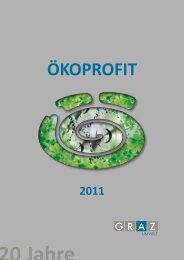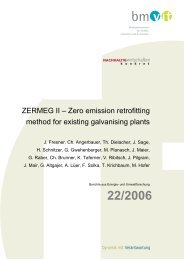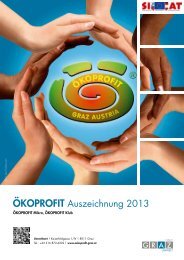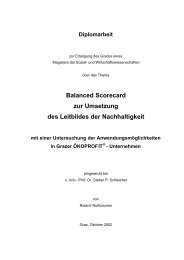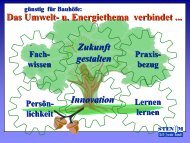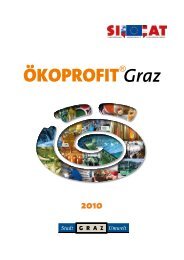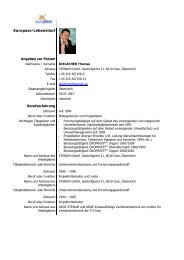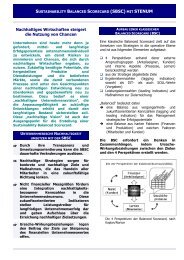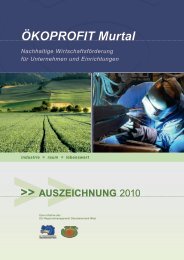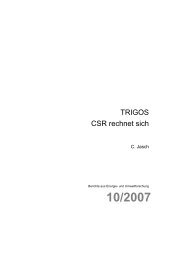Promoting Resource Efficiency in Small & Medium size ... - UNEP
Promoting Resource Efficiency in Small & Medium size ... - UNEP
Promoting Resource Efficiency in Small & Medium size ... - UNEP
You also want an ePaper? Increase the reach of your titles
YUMPU automatically turns print PDFs into web optimized ePapers that Google loves.
Benchmarks<br />
This chapter provides sector-specific benchmarks for a selection<br />
of <strong>in</strong>dustries <strong>in</strong>clud<strong>in</strong>g:<br />
• Textiles<br />
• Leather<br />
• Paper<br />
• Food and beverage<br />
• Metal manufactur<strong>in</strong>g<br />
See Section 2.8 for a brief explanation of the process of<br />
benchmark<strong>in</strong>g. As a first step, identify the relevant consumption<br />
from your thematic module: water, energy (electricity and/or heat),<br />
raw materials, waste. Then calculate the respective number for the<br />
company you are <strong>in</strong>vestigat<strong>in</strong>g and compare it to the numbers<br />
given here. Be aware of the range given. In case the range appears<br />
wide, or the numbers apparently do not match your experience,<br />
consult the relevant document for the technological description of<br />
the sector, the description of specifics of the companies sampled,<br />
the <strong>size</strong> of the enterprise or the product characterisation.<br />
The benchmarks <strong>in</strong>cluded <strong>in</strong> this tra<strong>in</strong><strong>in</strong>g manual are a part of the<br />
benchmarks <strong>in</strong>cluded <strong>in</strong> the electronic version of the toolkit. Most<br />
of the benchmarks <strong>in</strong>cluded here are taken from the best available<br />
technology reference notes (also known as BREF-notes).<br />
The European IPPC Bureau is a division of the Susta<strong>in</strong>able<br />
Production and Consumption Unit of the Institute for Prospective<br />
Technological Studies (IPTS), one of the scientific <strong>in</strong>stitutes of the<br />
European Commission’s Jo<strong>in</strong>t Research Centre (JRC). The Bureau<br />
was set-up to organise an exchange of <strong>in</strong>formation between<br />
Member States and <strong>in</strong>dustry on Best Available Techniques (BAT)<br />
and BAT associated monitor<strong>in</strong>g and developments.<br />
In the <strong>in</strong>ternational context, the European <strong>in</strong>formation exchange<br />
on BAT is considered to be a useful contribution from the EU<br />
to the global process <strong>in</strong>itiated <strong>in</strong> 2002 at the World Summit on<br />
Susta<strong>in</strong>able Development so that non-EU countries can also reap<br />
the benefits of this work. 98<br />
The electronic version of the BATs <strong>in</strong>cludes track<strong>in</strong>g numbers from<br />
equipment suppliers, case studies and a variety of other pert<strong>in</strong>ent<br />
manuals and studies. The benchmarks relation to different<br />
subsectors or to <strong>in</strong>dividual processes are <strong>in</strong>dicated. Most of the<br />
benchmarks relate energy, water or raw materials consumption to<br />
production.<br />
Also carefully check the units, especially when benchmark<strong>in</strong>g<br />
energy consumption. Convert kJ or MJ to kWh where relevant,<br />
or convert kg of fuel to kWh. For your reference: 1 standard cubic<br />
metre of natural gas or fuel oil roughly has a calorific value of 10<br />
kWh; coal, depend<strong>in</strong>g on the quality, about 6 to 7.<br />
If your company is produc<strong>in</strong>g a variety of products, try to compose<br />
<strong>in</strong>dicators by weigh<strong>in</strong>g <strong>in</strong>dicators for the <strong>in</strong>dividual products e.g.<br />
for the tannery process<strong>in</strong>g hide and sheepsk<strong>in</strong>, you might weigh<br />
the <strong>in</strong>dicators for hide process<strong>in</strong>g and sk<strong>in</strong> process<strong>in</strong>g accord<strong>in</strong>g<br />
to production and add to a benchmark.<br />
For several sectors water and energy consumption for <strong>in</strong>dividual<br />
unit operations are given. Aga<strong>in</strong> comb<strong>in</strong>e them to generate a<br />
benchmark for your process, consider<strong>in</strong>g the relevant units e.g.<br />
for the case of water consumption of cotton process<strong>in</strong>g to grey<br />
fabric, you will have to add the water consumption for de-siz<strong>in</strong>g<br />
and scour<strong>in</strong>g. In this case then merceris<strong>in</strong>g, dye<strong>in</strong>g, wet f<strong>in</strong>ish<strong>in</strong>g<br />
is not relevant.<br />
98) European Commission, Jo<strong>in</strong>t Research Center, 2008.<br />
89




